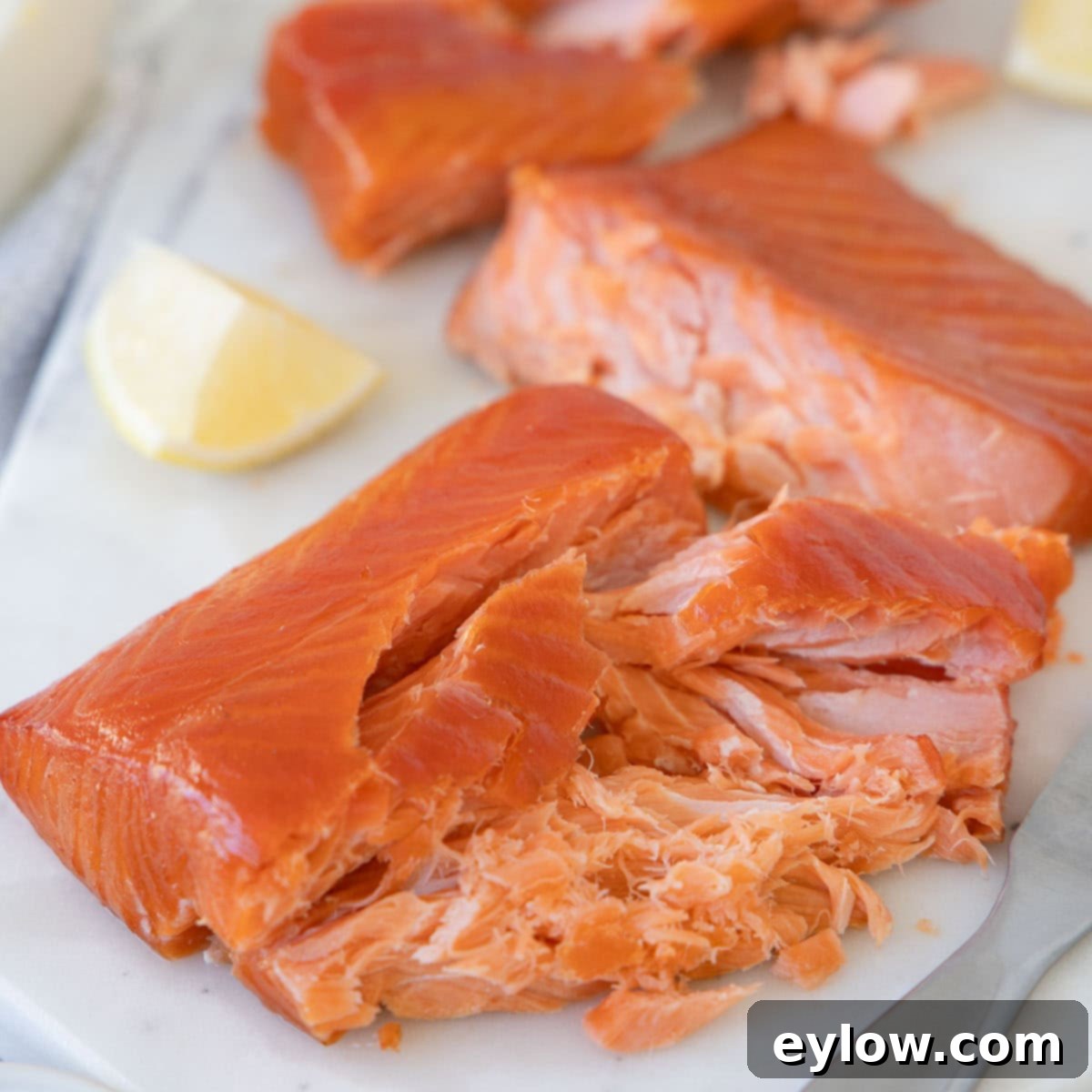The Ultimate Guide to Perfectly Smoked Salmon on a Pellet Grill
Discover the delightful experience of preparing **smoked salmon on a pellet grill** right in your own backyard. This method isn’t just incredibly flavorful, it’s also surprisingly easy to master, consistently yielding results that far surpass anything you can buy at the store. Our traditional hot-smoking technique utilizes a simple yet effective salt-and-sugar dry brine, often referred to as a “cure,” combined with a low-temperature smoke environment. This process works wonders, transforming fresh salmon fillets into tender, flaky, and subtly smoky delights, boasting a beautiful rich color and a profoundly deep flavor profile. Hot-smoked salmon is incredibly versatile, making it perfect for an elegant appetizer spread, a luxurious brunch alongside eggs, or flaked into vibrant salads, hearty grain bowls, or comforting pasta dishes.
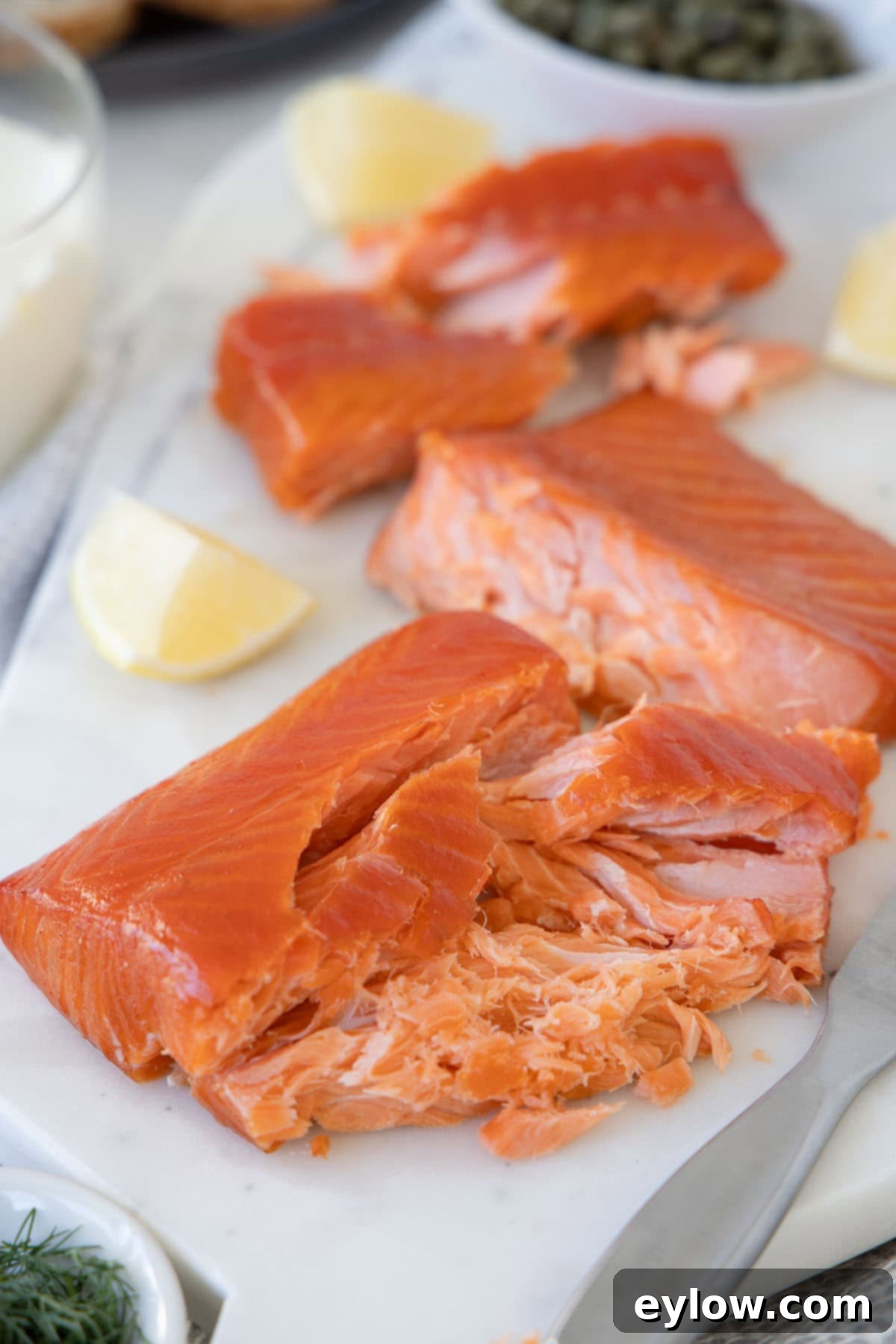
When most people think of smoked salmon, they often picture the thinly sliced, silky texture of cold-smoked varieties, commonly found draped over bagels with cream cheese or arranged artfully on charcuterie boards. However, smoked salmon prepared on a pellet grill offers a distinctly different, equally exquisite experience. Pellet smoked salmon is a hot-smoked product, meaning it’s gently cooked through at a consistent low temperature, typically around 180°F (82°C). This gentle cooking process ensures the salmon becomes incredibly tender and flaky, imbued with a delicate smoky flavor, and finished with a beautiful, subtle lacquered sheen. It’s truly delicious served in countless ways and remarkably simple to achieve at home with any standard pellet grill or dedicated smoker.
Why You’ll Adore Pellet Smoked Salmon
If you’re looking for a recipe that combines ease with gourmet results, this pellet smoked salmon is for you. Here’s why it’s bound to become a favorite in your cooking repertoire:
- Unforgettable Flavor: The combination of a carefully balanced cure and gentle wood smoke imparts an incredible depth of flavor. Each bite offers a delicate smokiness, a hint of natural sweetness, and a subtle warmth from carefully selected spices, creating a harmonious taste that’s truly gourmet.
- Superior to Store-Bought: Making your own smoked salmon guarantees a fresher taste and allows you to control every ingredient. You can enjoy the peace of mind knowing there are no artificial preservatives or unnecessary additives, just pure, wholesome goodness crafted exactly to your preference.
- Remarkably Versatile: Once prepared, this hot-smoked salmon can elevate almost any meal. Flake it into crisp salads, rich grain bowls, or comforting pasta dishes for a protein boost. Serve it as a sophisticated appetizer on crackers with cream cheese or whipped ricotta, or even integrate it into breakfast for a luxurious twist on eggs or avocado toast.
- Simple, Wholesome Ingredients: Despite its impressive flavor, this recipe relies on a straightforward list of ingredients: quality salmon, salt, sugar, and a few common pantry spices. This simplicity ensures that the natural flavor of the salmon truly shines through, enhanced rather than masked.
For those times when you need a relatively quicker smoking recipe, consider trying my smoked chicken breasts, which uses boneless, skinless chicken breasts for a delicious and efficient meal.
Essential Ingredients for Your Smoked Salmon
Crafting perfect smoked salmon starts with quality ingredients. Here’s a closer look at what you’ll need and why each component is important:
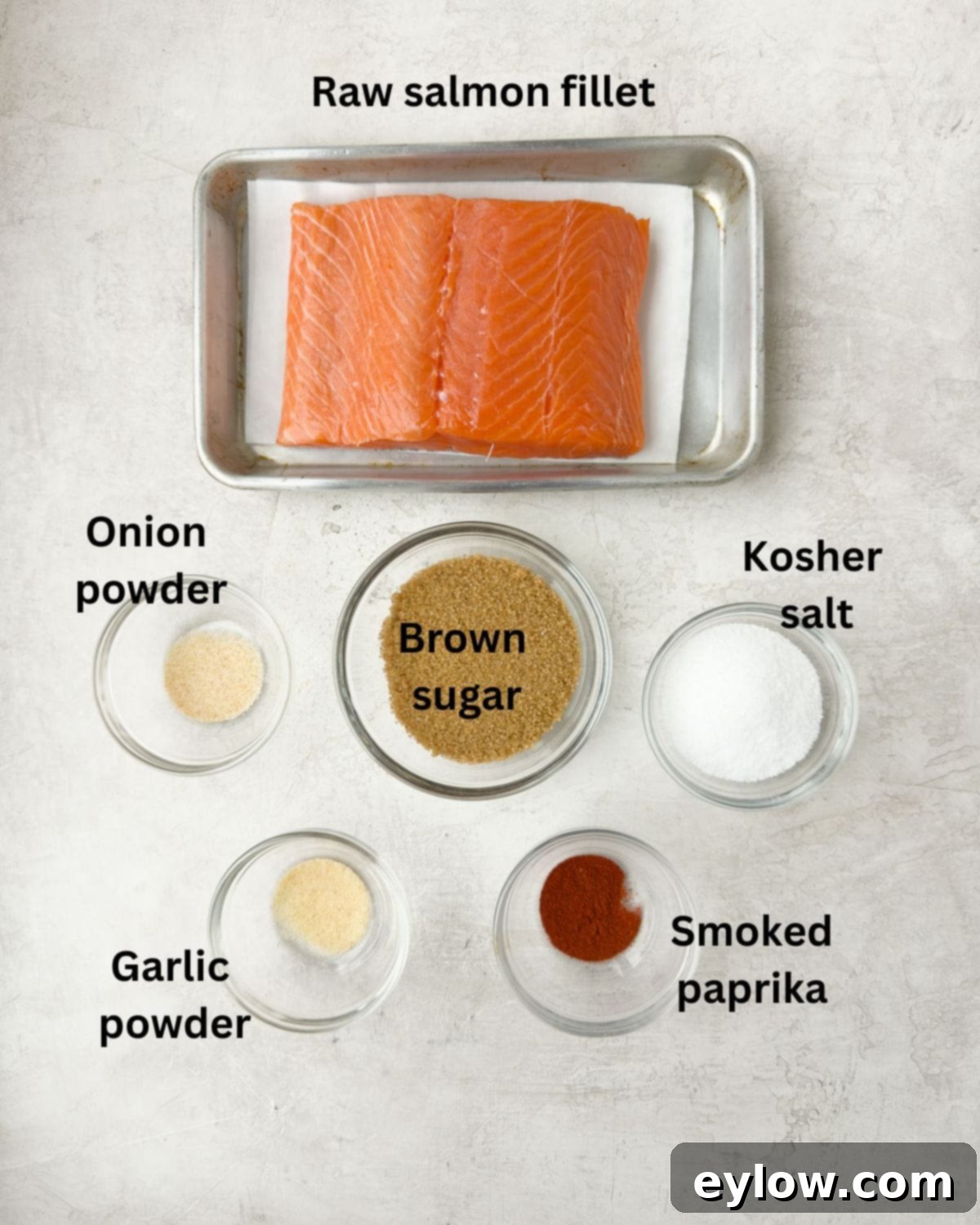
- Salmon: The star of our show! My top recommendation is fresh wild King (Chinook) salmon, especially when it’s in season, due to its high fat content and rich, buttery texture. Opt for a center-cut fillet to ensure uniform thickness, which promotes even curing and smoking, leading to the most tender results. Coho or sustainably farmed salmon are also excellent choices, and don’t hesitate to use high-quality frozen fillets, properly thawed. More detailed notes on salmon selection are provided below.
- Sugar: Light brown sugar is preferred for its subtle molasses notes, which add a delightful depth and contribute to a beautiful caramelized finish. White granulated sugar can also be used for a cleaner, more neutral flavor. Whichever you choose, the sugar is crucial for balancing the salt in the cure and aiding in the development of that desirable glossy exterior during smoking.
- Salt: Always use kosher salt for this recipe. The coarse grains and lack of iodine create a pure flavor and allow for more controlled curing. It’s important to note that salt densities can vary significantly between brands (e.g., Diamond Crystal vs. Morton), so be sure to adjust the amount according to the specific brand you are using, as detailed in the recipe card.
- Spices: A carefully chosen blend of granulated garlic, onion powder, and smoked paprika works harmoniously to enhance the natural richness of the salmon without overwhelming its delicate flavor. These spices contribute a savory backbone and a subtle smoky aroma even before the salmon hits the grill.
You’ll find precise measurements for these ingredients, along with an optional mention for black pepper, in the comprehensive recipe card below.
Chef’s Tip – How Much Salmon to Buy
When planning your smoked salmon, remember that fish loses a significant amount of its weight during the curing and smoking processes. Expect approximately a 25-30% reduction in weight. This means a 1 ¼-pound (about 560g) raw fillet will typically yield closer to 13-14 ounces (about 370-400g) of finished product after shrinkage and trimming the skin. To ensure you have enough, plan on serving 4-6 ounces (113-170g) of cooked salmon per person if it’s the main course, or about 2 ounces (56g) per person when offered as an appetizer.
For a super easy and fast salmon recipe that doesn’t involve smoking, consider these steamed salmon fillets.
Choosing the Best Salmon for Your Pellet Smoker
The type of salmon you choose can significantly impact the final texture and flavor of your hot-smoked creation. Here’s a breakdown of popular choices:
- King Salmon (Chinook): Often considered the gold standard for smoking, King salmon is the richest and fattiest of the wild salmon species. Its high oil content contributes to a luxuriously buttery texture that remains incredibly moist and forgiving during the long smoking process. Thicker fillets may require a slightly longer smoking time to reach the ideal internal temperature.
- Coho Salmon: A fantastic alternative, Coho salmon is leaner and has a milder flavor compared to King, with a medium fat content. It’s often sold in thinner fillets, which means it might cook a bit faster at lower smoking temperatures. Coho offers a beautiful balance of flavor and texture.
- Sockeye Salmon: Renowned for its vibrant deep red color and bold, distinctive flavor. Sockeye is very lean, which makes it more prone to drying out if not monitored carefully. If using Sockeye, pay close attention to the internal temperature to prevent overcooking and preserve its delicate moisture.
- Farmed Salmon: Widely accessible and a consistently reliable choice when wild salmon isn’t available. Most farmed salmon is Atlantic salmon (a different species from wild Pacific varieties). The flavor and sustainability ratings for farmed salmon can vary, so it’s worth doing a little research. Scottish and British Columbia farmed salmon are often highly regarded for their quality, while premium New Zealand Ōra King salmon is considered an exceptional farmed variety, mirroring the quality of wild King.
For comprehensive and up-to-date sustainability ratings, I highly recommend checking the Monterey Bay Aquarium’s Seafood Watch guide on salmon.
Fresh Salmon vs. Frozen Salmon: What You Need to Know
Don’t be hesitant to use frozen salmon for smoking; properly handled, thawed salmon can yield results just as excellent as fresh. In fact, many prefer it, as freezing effectively kills parasites and can sometimes even firm up the flesh, contributing to a better texture. The key to success lies in proper handling:
- Freezing: If freezing fresh salmon yourself, do so quickly and in airtight packaging to minimize the formation of large ice crystals, which can damage the delicate cell structure and affect texture upon thawing.
- Thawing: Always thaw frozen salmon slowly in the refrigerator overnight. This gentle thawing process helps maintain the best possible texture and moisture content.
- Post-Thaw Preparation: After your salmon has completely thawed, proceed with the curing process as described in the recipe. Following the cure, it’s crucial to place the salmon uncovered on a wire rack in the refrigerator for the drying phase. This step is essential for forming what’s known as a **pellicle**—a dry, slightly tacky surface that allows the smoke to adhere beautifully and locks in flavor, contributing to that desirable glossy finish.
Creative Substitutions and Flavor Variations
While the basic smoked salmon recipe is perfect as is, you can easily customize it to suit your palate or experiment with new flavor profiles:
- Elevate the Spice: For those who appreciate a bit of heat or a more complex spice blend, try adding a pinch of cayenne pepper, chipotle powder for a smoky kick, ground coriander for a citrusy note, or cumin for an earthy depth to your dry brine. Mix these into the cure with the salt and sugar for an infused flavor.
- Add a Final Glaze: For a different finish and an extra layer of flavor, consider glazing your salmon during the last 15 minutes of smoking.
- Sweet Maple: A simple brush of pure maple syrup adds a subtle caramel note that beautifully complements the smoky salmon.
- Tangy Honey-Dijon: For a balanced tangy-sweet profile, whisk together Dijon mustard with a touch of honey. This creates a vibrant glaze that pairs wonderfully with the rich fish.
- Spicy Kick: If you love heat, stir a pinch of cayenne or chipotle powder into your maple syrup or honey-Dijon glaze before applying it.
Looking for another fantastic pellet grill recipe? You absolutely must try this smoked salsa recipe!
Chef’s Tip – The Pellicle: Your Secret to Exceptional Smoked Salmon
The pellicle is more than just a dry surface; it’s a vital component in achieving truly exceptional hot-smoked salmon. This thin, slightly tacky layer develops on the cured salmon during the drying phase in the refrigerator. Its purpose is twofold: it provides an ideal surface for the smoke to better adhere to the fish, ensuring deep smoke penetration and flavor, and it also contributes to the beautiful glossy finish and rich, deep color of the final product. The pellicle may look a little shiny and feel sticky to the touch, and that’s exactly what you want! Do not skip this step: a well-formed pellicle is the defining characteristic that elevates average smoked salmon to extraordinary.
Step-by-Step: Smoking Salmon on a Pellet Grill
Patience is a virtue when it comes to perfect smoked salmon. This process requires a bit of planning, with approximately 24 hours from start to finish. This includes up to 12 hours for the crucial curing phase, another 10-12 hours for drying and pellicle formation, and about 3 to 3 ½ hours of actual smoking, depending on the thickness of your salmon fillet and your smoker’s temperature.
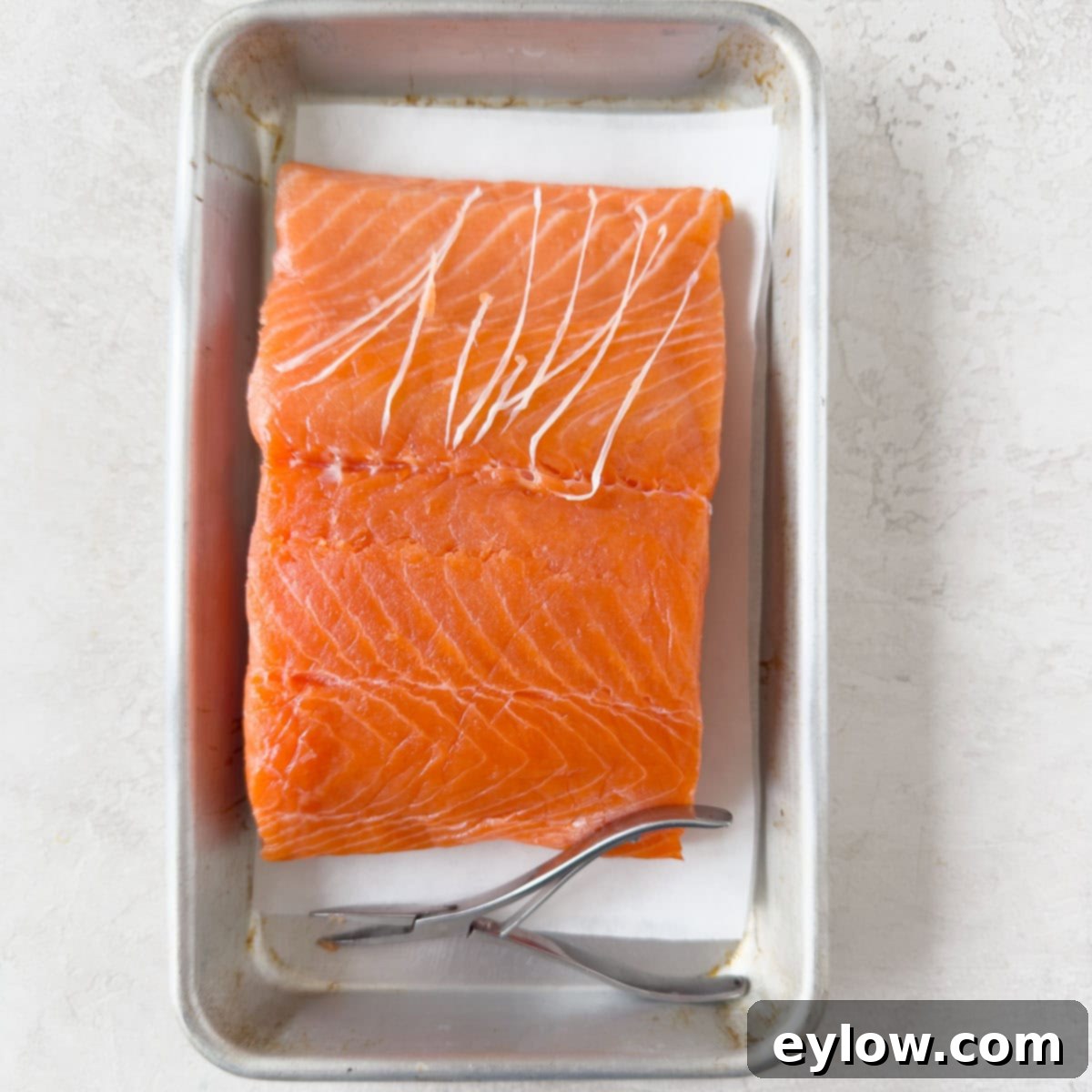
- Begin by carefully unwrapping your salmon fillet. Before applying the cure, ensure all pin bones are removed using tweezers or small pliers. Leaving the skin on is recommended, as it protects the delicate flesh and makes the fillet easier to handle throughout the process.

- In a small bowl, thoroughly mix your dry cure ingredients. Place the salmon skin-side down on a parchment-lined, rimmed baking sheet. Liberally cover the entire top surface of the salmon fillet with a generous layer of the cure mixture, gently patting it on to ensure it adheres well. You might not use all of the cure, depending on the exact size of your fillet.
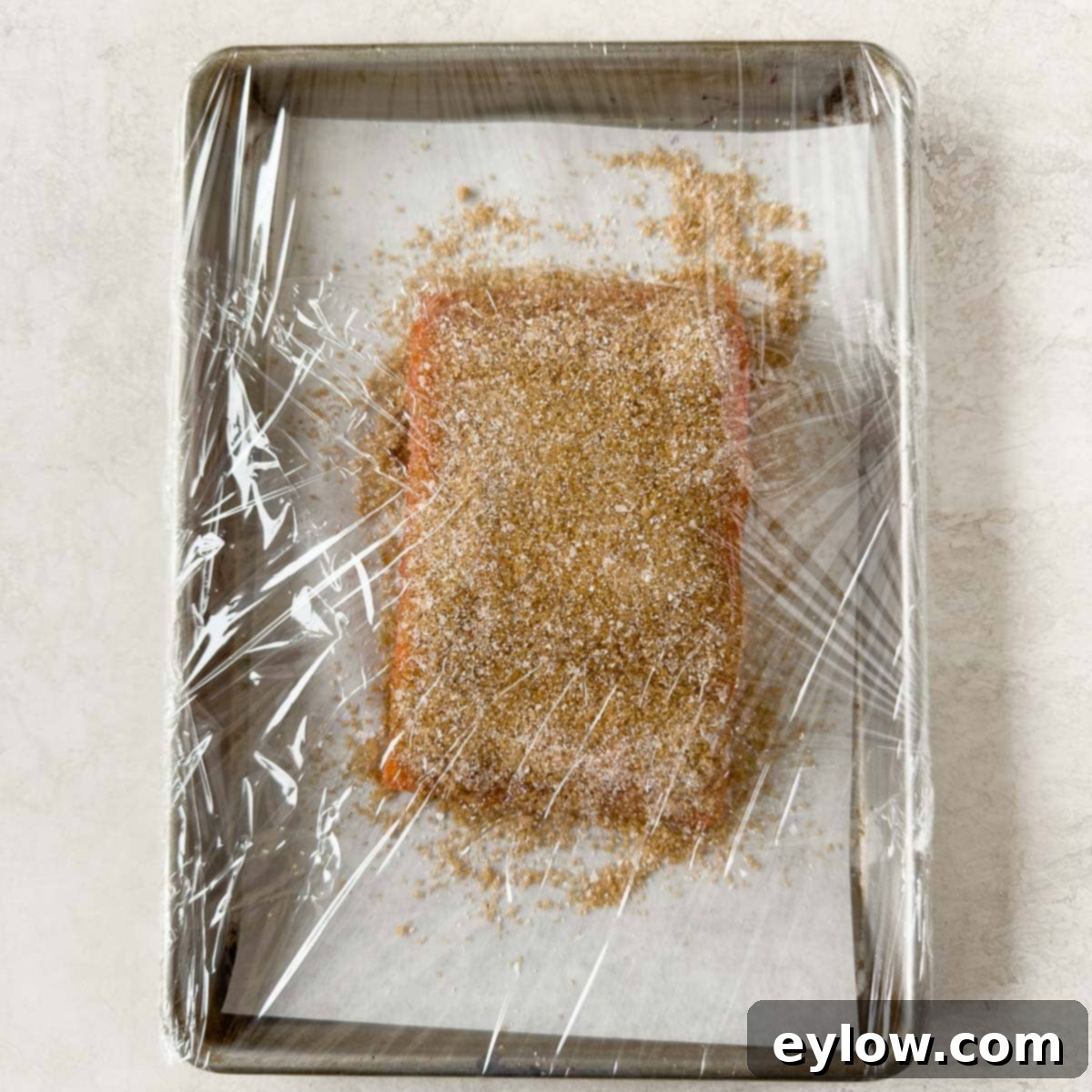
- Once the salmon is fully coated, tightly wrap the entire curing fillet with plastic film. This creates an anaerobic environment that helps the cure penetrate evenly. Transfer the wrapped salmon to the refrigerator and allow it to cure for a period of 10-12 hours. This time frame is essential for moisture extraction and flavor development.

- After the curing time has elapsed, carefully unwrap the salmon fillet. You’ll notice some liquid has been drawn out, which is a sign the cure has done its job. The salmon may also appear slightly firmer and a bit darker in color.
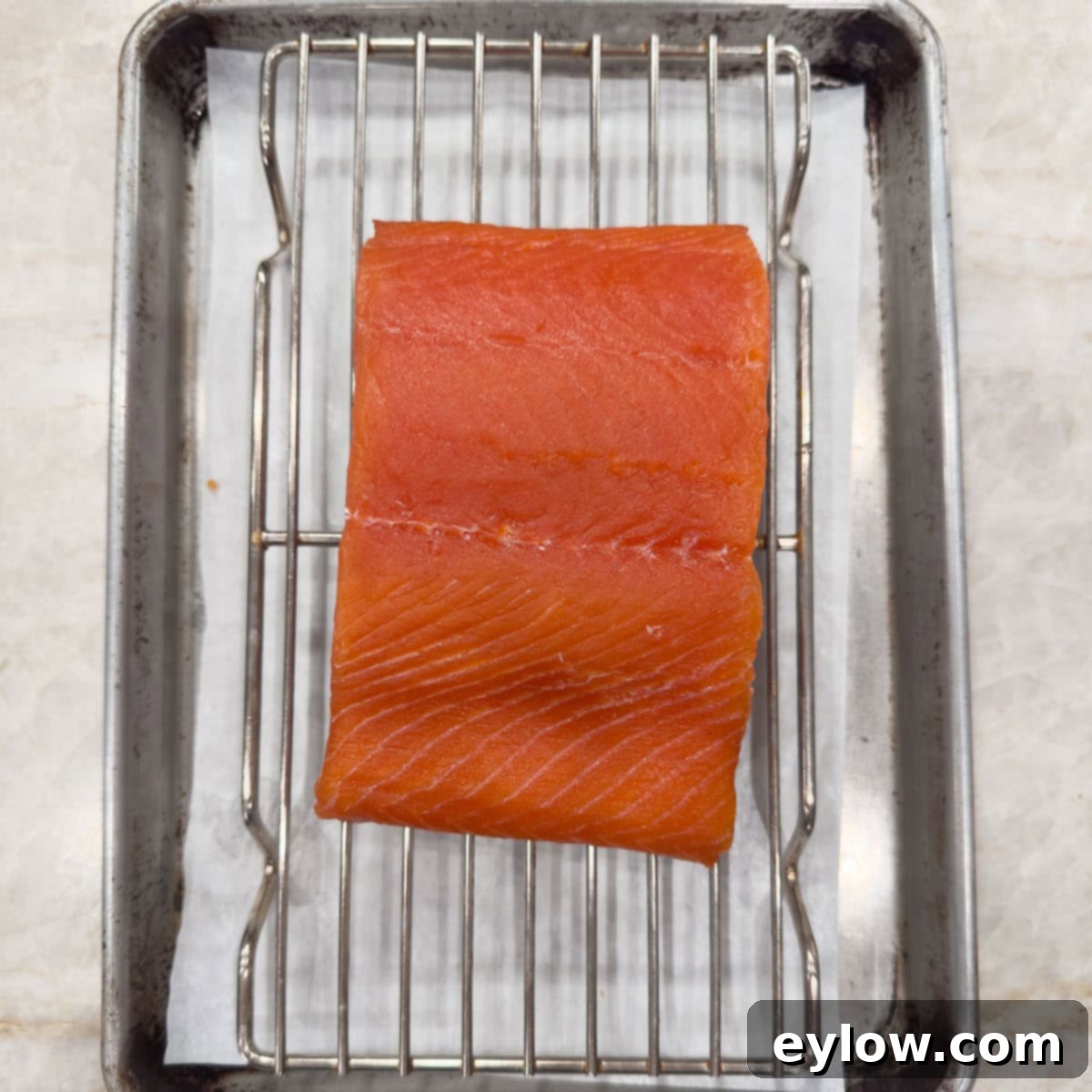
- Thoroughly rinse all traces of the cure mixture from the fillet under cold running water. This prevents the salmon from becoming too salty. Once rinsed, pat the fillet exceptionally dry with paper towels. Any excess moisture will hinder pellicle formation and smoke adhesion.
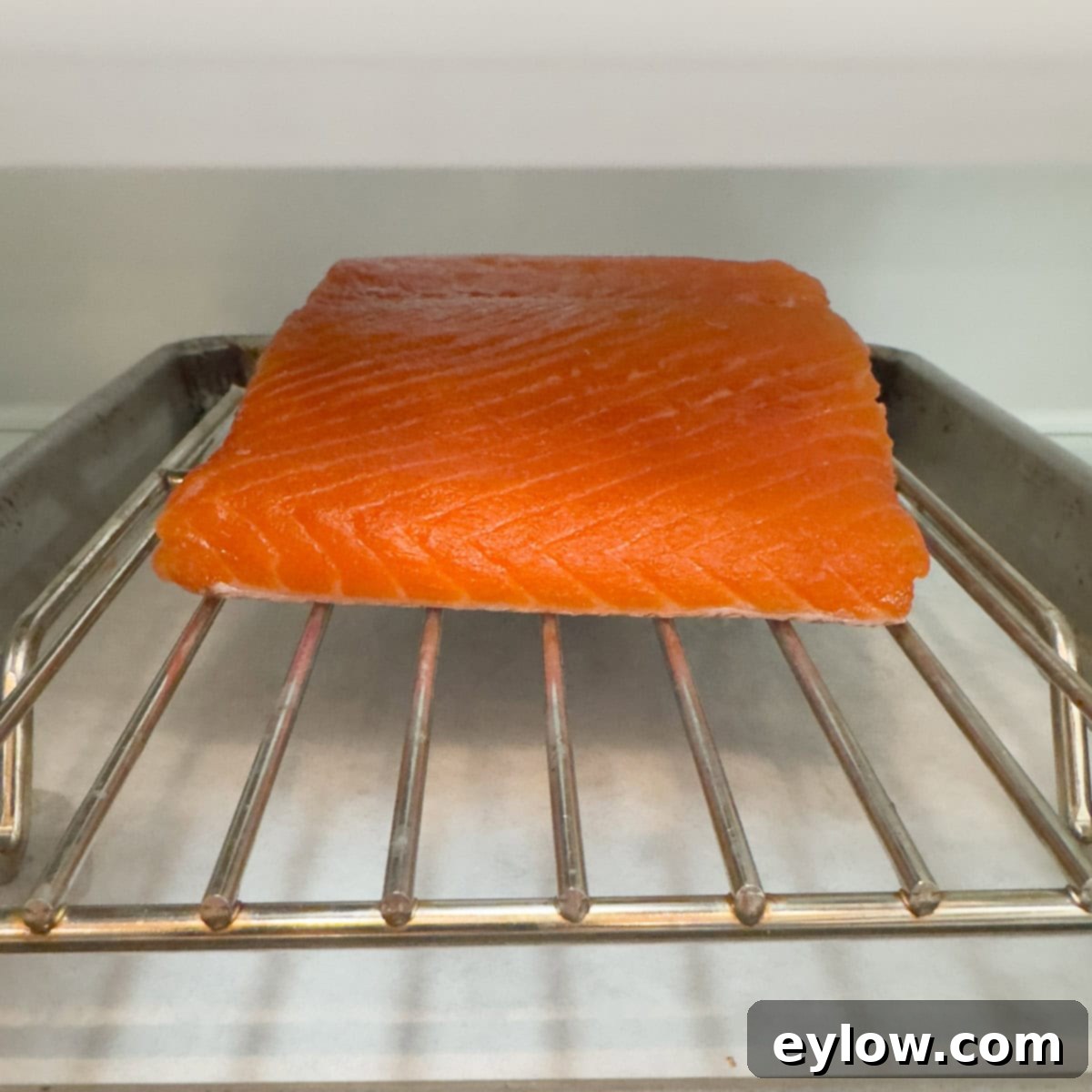
- For optimal airflow and pellicle formation, place the patted-dry fillet on a wire rack set over a rimmed baking sheet. Leave it uncovered in the refrigerator for a dedicated drying period of 10-12 hours (or even up to 13). This step is non-negotiable for achieving that perfect smoky flavor and glossy exterior.
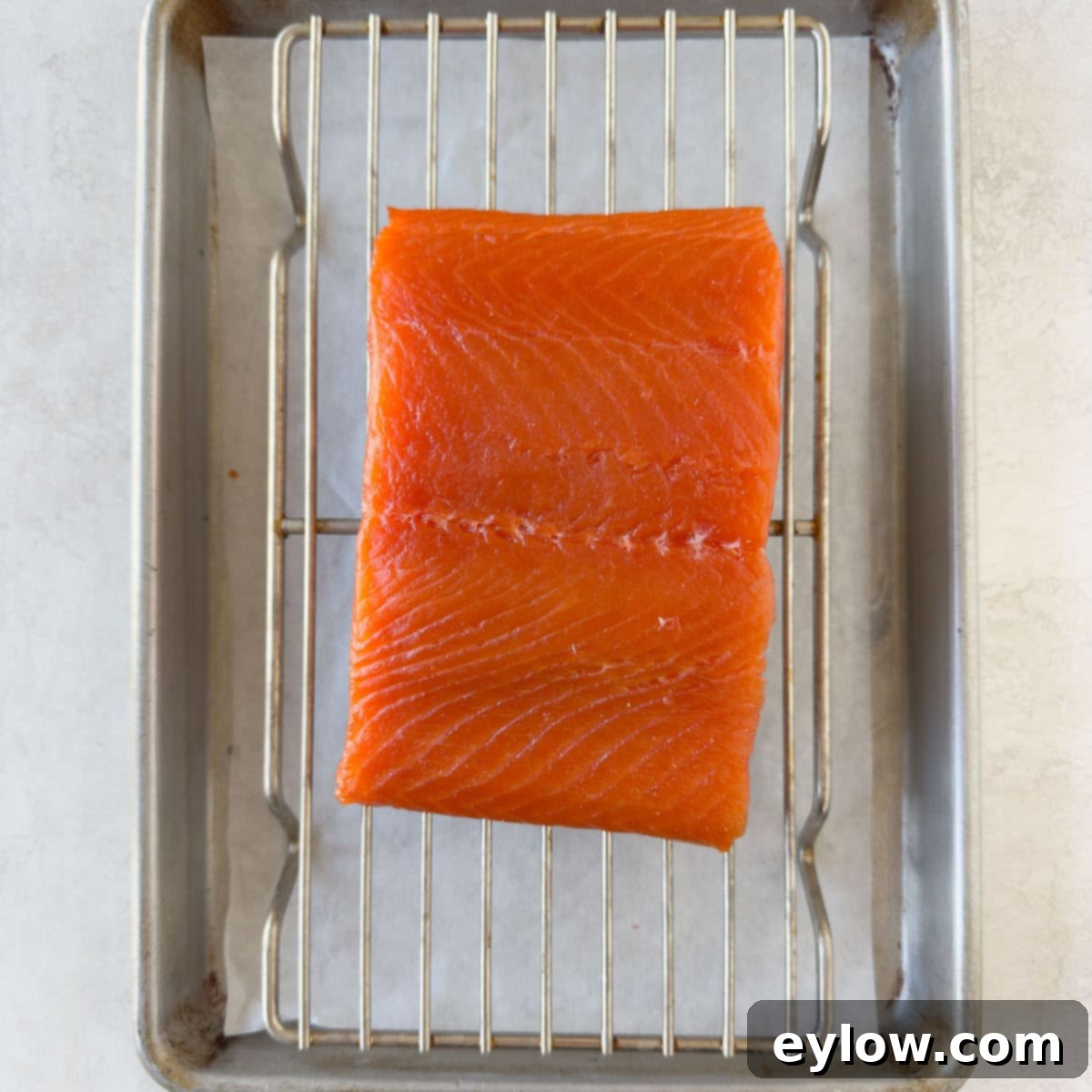
- This image shows the beautifully cured and dried salmon fillet, now with a perfectly formed pellicle. Notice the slightly tacky, glistening surface – this is exactly what you want for superior smoke adhesion and a fantastic final product.
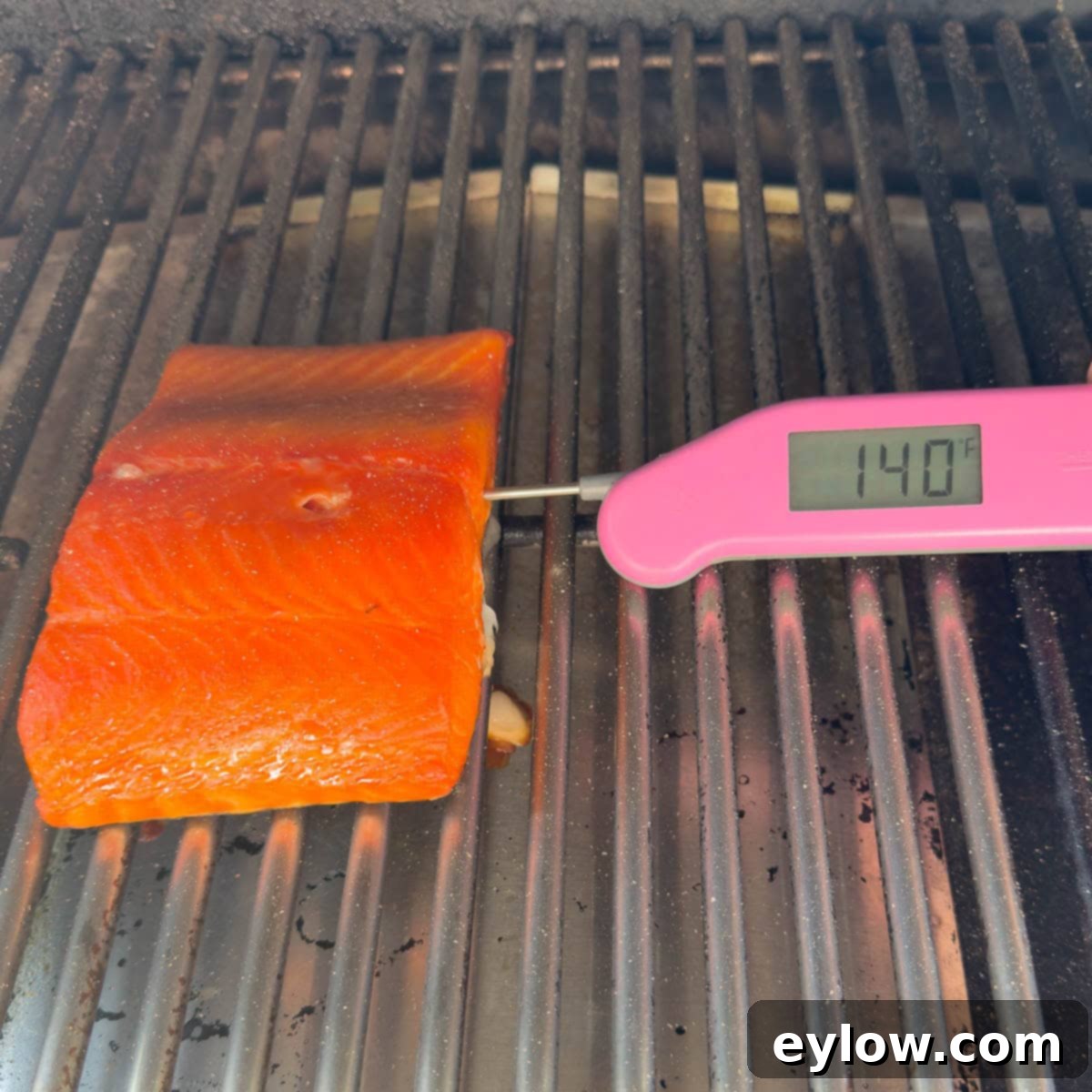
- Preheat your pellet grill to a stable temperature of 180°F (82°C). If your grill has a “Super Smoke” setting, engage it for maximum smoke flavor. Carefully place the pellicle-formed salmon fillet directly onto the grill grates. Smoke for approximately 3 to 3 ½ hours, or until the thickest part of the salmon reaches an internal temperature of 140°F (60°C). Monitor your grill occasionally and ensure pellet levels are sufficient.

- Once the salmon has reached its target internal temperature, remove it from the grill. For serving, turn the fillet over (skin-side up) and gently peel off the skin. If desired, use a small paring knife to carefully scrape off the darker, often purplish-gray “bloodline” found just beneath where the skin was. This is optional but can improve the appearance and sometimes the flavor.

- Your perfectly smoked salmon is now complete and ready to be enjoyed! Slice it, flake it, or serve it as a whole fillet. The rich color, tender texture, and deep smoky flavor are sure to impress.
How Long to Smoke Salmon on a Pellet Grill for Perfect Results
Achieving perfectly smoked salmon relies heavily on monitoring temperature rather than strictly adhering to a timer. Here’s what you need to know:
- Focus on Internal Temperature: The most critical factor is the internal temperature of the salmon. It is considered perfectly cooked and safe to eat when it reaches 140°F (60°C) in its thickest part. A reliable meat thermometer (either built-in or a wireless probe) is your best friend here.
- Estimated Smoking Time: At a consistent grill temperature of 180°F (82°C), a typical 1 to 1.5-pound (450-680g) salmon fillet will usually take between 3 and 3 ½ hours to reach the target internal temperature.
- Thickness Matters: Thicker cuts of King salmon, with their higher fat content, might require a slightly longer smoking period. Conversely, thinner fillets of leaner species like Coho or Sockeye salmon may cook through a bit faster, so be extra vigilant with your thermometer.
- Avoid Higher Temperatures: While you might be tempted to increase the smoker temperature to 200-225°F (93-107°C) to speed up the process, I strongly advise against it. Smoking at higher temperatures will result in less smoke penetration and flavor, and significantly increases the risk of “albumin leakage”—those unattractive white protein spots that appear on the surface of overcooked fish. The “low and slow” method ensures maximum flavor and a beautiful presentation.
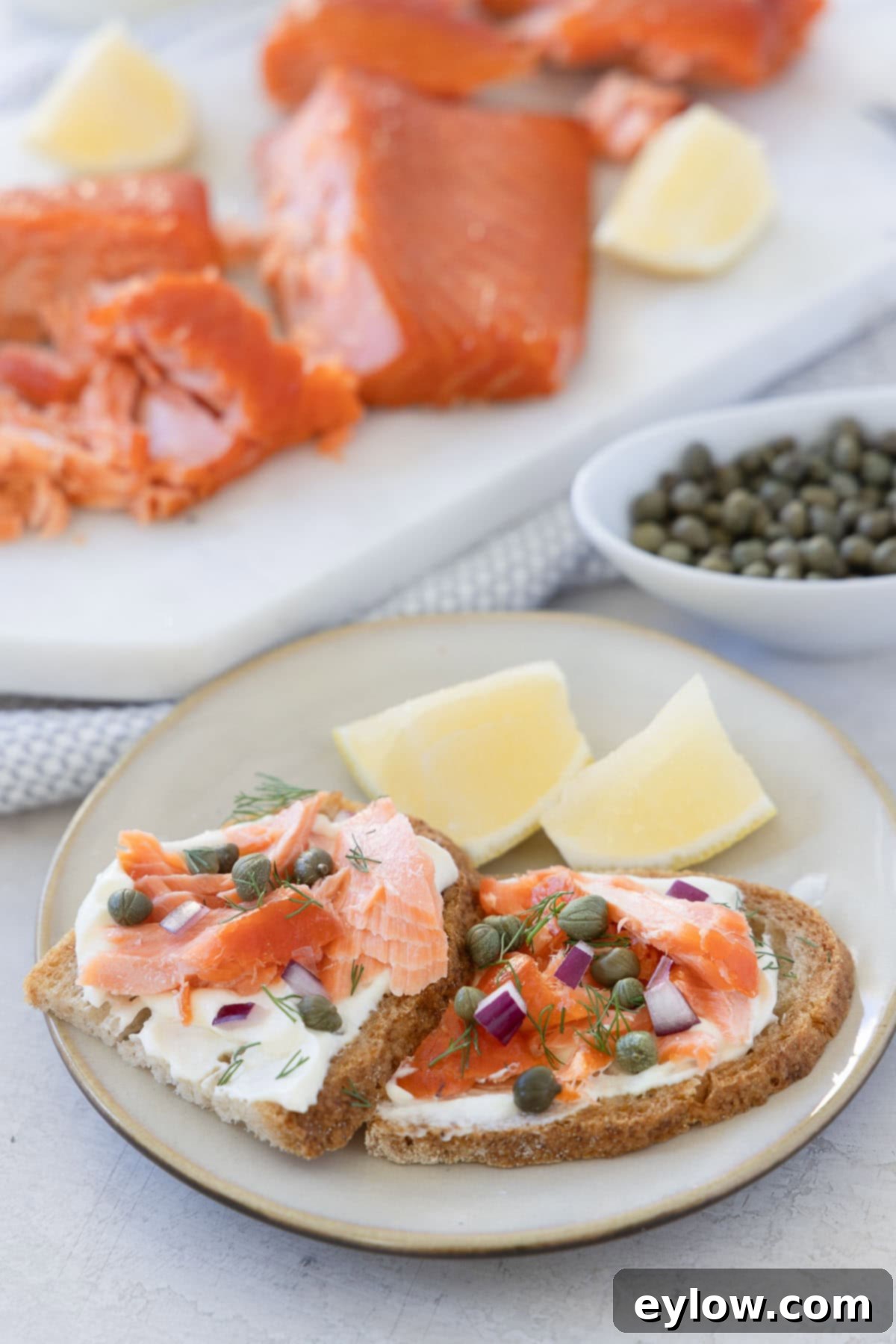
Creative Serving Ideas for Your Smoked Salmon
Hot-smoked salmon is an incredibly versatile ingredient, fitting seamlessly into meals from morning to night. Its rich flavor and tender texture make it a delightful addition to almost any dish:
- Classic Brunch: Pair it with toasted bagels, a generous smear of cream cheese, thinly sliced red onion, and fresh dill for a timeless breakfast or brunch favorite.
- Fresh Salads: Flake the smoked salmon into vibrant, crisp salads. It adds a hearty, smoky, and healthy protein punch that transforms a simple salad into a satisfying meal.
- Elegant Appetizers: Get creative with your hors d’oeuvres! Top creamy deviled eggs with a small piece of flaked salmon, or serve it on cucumber bites with a dollop of créme fraîche for a refreshing starter.
- Breakfast Favorites Reinvented: Beyond bagels, enjoy smoked salmon alongside scrambled or poached eggs, atop a perfectly ripe avocado toast, or diced into a flavorful smoked salmon hash.
- Hearty Lunch & Dinner: Toss flaked salmon into warm pasta dishes with a light cream sauce, stir it into creamy risotto, or add it to wholesome grain bowls for a boost of flavor and nutrition. It can also be layered onto homemade pizza for a sophisticated topping, or rolled into sushi and wraps for a quick and delicious meal.
- Gourmet Appetizer Platters: Arrange your smoked salmon on a platter with traditional accompaniments like capers, red onion, and fresh dill. For a decadent touch, serve it with a side of crackers and either classic cream cheese or a luscious whipped ricotta.
Storing Your Delicious Smoked Salmon
Proper storage ensures your hot-smoked salmon remains fresh and flavorful for days. Once cooled to room temperature, transfer your smoked salmon to an airtight container and store it in the refrigerator. It will keep beautifully for 3 to 5 days. Interestingly, many find that the flavors of the salmon actually deepen and meld even further after resting overnight, so there’s no need to rush to eat it all immediately!
Expert Freezing Tips for Long-Term Enjoyment
Yes, pellet smoked salmon freezes exceptionally well, allowing you to enjoy your efforts long after the initial smoke. To freeze it correctly and preserve its quality:
- Preparation: Once your smoked salmon has fully cooled, divide it into convenient serving-sized portions.
- Wrapping: Tightly wrap each portion individually in plastic wrap, ensuring as little air as possible is trapped around the fish.
- Container: Place the wrapped portions into a freezer-safe bag or a rigid airtight container. This double layer of protection helps prevent freezer burn.
- Labeling: Clearly label and date your packages. This helps you keep track of freshness.
- Freezing Duration: Smoked salmon can be stored in the freezer for up to 2 months while maintaining optimal quality.
- Thawing: For the best texture and flavor, thaw frozen smoked salmon slowly overnight in the refrigerator. Avoid quick thawing methods, as these can negatively impact the delicate texture.
While thawed smoked salmon might be slightly less tender and moist than a freshly smoked fillet, it remains an excellent ingredient, perfect for flaking into salads, stirring into pasta dishes, or scrambling with eggs for a quick and flavorful meal.
Frequently Asked Questions About Smoked Salmon
Absolutely! The world of smoked salmon offers diverse methods. Some recipes opt for hot-smoking salmon at higher temperatures, typically around 225°F (107°C), which results in a firmer, flakier texture. Other approaches, like the one detailed in this recipe, employ a more traditional hot-smoking method, utilizing lower and slower temperatures, generally between 165-185°F (74-85°C), to achieve an incredibly tender salmon with a much deeper, more infused smoke flavor. There’s also cold-smoked salmon, which is cured and smoked at temperatures below 86°F (30°C) without actually cooking the fish. Cold smoking usually requires specialized equipment and is more commonly performed in commercial settings, making it less practical for home cooks.
Gravlax is a distinct Nordic preparation of salmon that is often confused with smoked salmon, but it’s fundamentally different because it is never smoked. Instead, gravlax is cured with a mixture of salt, sugar, and fresh herbs – with fresh dill being the most traditional and prominent ingredient. The salmon is typically left to cure in the refrigerator for 2-3 days. The result is a delicate, silky textured salmon with a vibrant, herbal flavor profile, distinct from the smoky notes of hot or cold-smoked salmon.
While the USDA recommends an internal temperature of 145°F (63°C) for cooked fish, for hot-smoked salmon, you can aim for 140°F (60°C) for a noticeably more tender and moist texture. If you prefer a firmer, more cooked-through consistency, you can extend the smoking time until it reaches up to 150°F (66°C). Always use a reliable meat thermometer inserted into the thickest part of the fillet to ensure accuracy.
For smoking salmon, it’s best to choose milder wood pellets that complement its delicate flavor without overpowering it. Many enthusiasts prefer fruit woods like alder, apple, or cherry for their subtle, sweet smoke. Alder is a classic choice, particularly for fish. Pecan can also be a nice option, offering a slightly nutty, robust flavor that still pairs well. You should definitely avoid strong, pungent woods like mesquite or hickory, as their intense smoke flavor will likely overwhelm the salmon. Using a blend of milder woods is often a great strategy to achieve a complex yet balanced smoke profile.
Yes, absolutely! You can successfully smoke frozen salmon on a pellet grill, but there’s a crucial prerequisite: the salmon must be completely thawed first. This ensures that the curing mixture can penetrate evenly and that the salmon smokes uniformly. To thaw it properly, transfer the frozen salmon to your refrigerator and allow it to thaw slowly overnight. Once fully thawed, proceed with the exact same curing, drying (pellicle formation), and smoking process as you would for fresh salmon.
Explore More Pellet Grill Recipes!
Are you, like me, a big fan of your pellet grill? There’s so much more you can create with it! Be sure to check out more incredible pellet grill recipes and general grilling recipes on the comprehensive grill and smoker recipe index page. Expand your repertoire and enjoy the versatility of your smoker!
- Smoked Pork Tenderloin (pellet grill)
- Grilled Buffalo Chicken
- 3-2-1 Ribs (Smoked Baby Back Ribs Recipe)
- Smoked Turkey Breast (Bone-In, No Brine)
Did You Make This Recipe?
If you’ve had the pleasure of making this incredible smoked salmon recipe, I would love to hear from you! Please take a moment to add your comment below and let me know which version you tried and how it turned out. Your feedback is incredibly valuable and helps other readers in their cooking journey. If you loved the recipe, please consider giving it a 5-star rating!
📖 Recipe
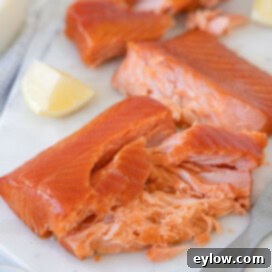
Smoked Salmon on a Pellet Grill
Sally Cameron
Pin Recipe
Equipment
-
Pellet grill or other smoker
-
pellets
-
Rimmed baking sheet
Ingredients
Salmon
- 1 – 1 ½ pounds fresh salmon see salmon notes in post
Smoked salmon cure
- 6 tablespoons brown sugar or white
- 2-3 tablespoons kosher salt notes below on salt brands
- ½ teaspoons smoked paprika
-
¼
teaspoon onion powder
-
¼
teaspoon garlic powder
-
¼
teaspoon black pepper optional
Optional glaze
- 2 tablespoons maple syrup for spice add a pinch of chipotle or cayenne
Instructions
24 hours ahead
-
Mix the cure. After removing salmon from the wrapping, be sure to remove any pin bones, place the salmon skin side down on a rimmed baking sheet on parchment and cover the salmon top well with the cure mix. You might not use it all depending on the size of your salmon fillet. Pat it on the salmon. Cover tightly with plastic wrap and refrigerate for 10-12 hours.
-
After the salmon has cured, rinse off cure and pat dry well with paper towels. Place salmon on a rimmed baking sheet with parchment on top of a wire rack for air circulation and allow to dry to create the pellicle, 10-12 hours.
Smoke salmon
-
Remove the salmon from the refrigerator 45-60 minutes ahead of smoking. Be sure the grill is full of pellets and the grates are clean. Set the temperature to 180°F and super smoke (if you have the setting).
-
When the grill is hot, place the salmon fillet on the grill center. Use either a bulit-in probe or a wireless thermometer to be able to monitor cooking temperature. Salmon will take approximately 3- 3/12 hours depending on multiple factors. Cook to temperature not time.
-
When the salmon has reached 140°F, remove from the grill. Carefully turn the fillet over and peel off the skin. With a paring knife, scrape off the bloodline, the darker purple gray area under the salmon skin. Turn salmon over, and serve.
Storing and Freezing
-
Hot-smoked salmon keeps well in the refrigerator for 3 to 5 days in an airtight container. The flavor actually deepens a little after resting overnight, so don’t feel like you need to eat it all right away.
To freeze, wrap well and use a freezer-safe bag or airtight container. Label and date it, then freeze for up to 2 months. Thaw overnight in the refrigerator for the best texture.
Notes
Chef’s Tip – How Much Salmon to Buy
Smoked salmon loses about 25–30% of its weight during curing and smoking. A 1 ¼-pound fillet will finish closer to 13–14 ounces after shrinkage and trimming the skin. Plan on 4-6 ounces cooked salmon per person for a main dish, or 2 ounces if serving as an appetizer.
For serving suggestions, please see the post.
